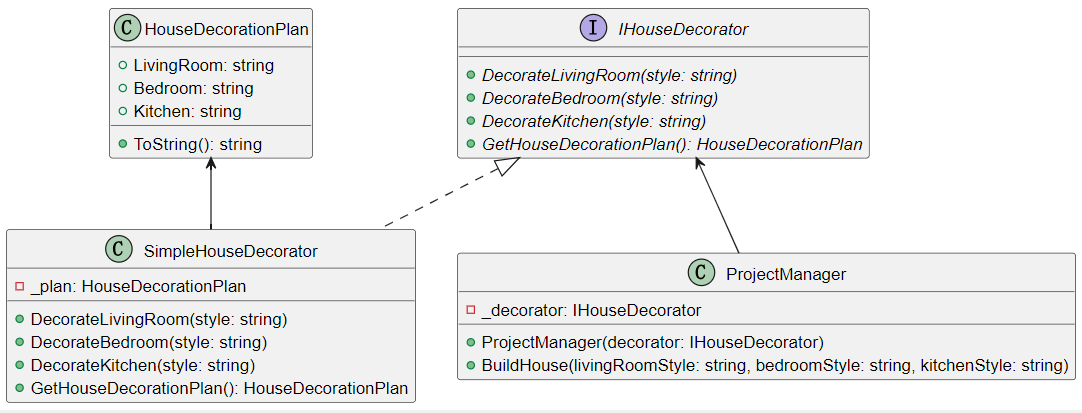建造者模式
简介
建造者模式(Builder Pattern)是一种创建型设计模式,用于构建复杂对象。它的主要目的是将对象的构建过程与其表示分离,使得同样的构建过程可以创建不同的表示形式。这种模式通常适用于创建对象的参数较多,且某些参数之间存在复杂的依赖关系的情况。
在建造者模式中,通常会有一个建造者(Builder)接口或抽象类,定义了构建对象所需的各种方法。然后有一个具体的建造者类实现了这个接口,负责实际构建对象的过程。最后,还有一个指挥者(Director)类,它负责根据一定的构建流程,使用建造者来构建对象。
案例
假设你是一位房屋装修公司的项目经理,你负责根据客户的需求和喜好来设计他们的家居装修方案。这个场景也可以很好地使用建造者模式来完成。
在这个场景中:
- 产品(Product):家居装修方案,包含客厅装修、卧室装修、厨房装修等。
- 抽象建造者(Builder):装修方案建造者接口,定义了构建装修方案所需的各种方法,如设计客厅、设计卧室、设计厨房等。
- 具体建造者(ConcreteBuilder):实现了装修方案建造者接口,负责根据客户的需求和喜好构建装修方案。
- 指挥者(Director):负责指导具体的构建过程,根据客户的需求来决定如何调用具体建造者来构建装修方案。
- 客户端(Client):客户通过与项目经理沟通,提供自己的需求和喜好,最终得到定制的家居装修方案。
例如,客户可能希望他们的客厅采用现代风格,卧室采用简约风格,厨房采用欧式风格。具体的构建过程可能是:
- 客户提供客厅现代风格的需求,指挥者调用具体建造者来设计现代风格的客厅。
- 客户提供卧室简约风格的需求,指挥者调用具体建造者来设计简约风格的卧室。
- 客户提供厨房欧式风格的需求,指挥者调用具体建造者来设计欧式风格的厨房。
最终,客户得到了一个定制的家居装修方案,满足了他们的需求和喜好。
通过建造者模式,你可以很好地实现家居装修方案的定制功能,使客户可以根据自己的喜好和需求来设计自己的家居装修,而不需要知道装修方案是如何构建的具体细节。
using System; // 产品类 - 家居装修方案 class HouseDecorationPlan { public string LivingRoom { get; set; } public string Bedroom { get; set; } public string Kitchen { get; set; } public override string ToString() { return $"Living Room: {LivingRoom}, Bedroom: {Bedroom}, Kitchen: {Kitchen}"; } } // 抽象建造者接口 interface IHouseDecorator { void DecorateLivingRoom(string style); void DecorateBedroom(string style); void DecorateKitchen(string style); HouseDecorationPlan GetHouseDecorationPlan(); } // 具体建造者类 class SimpleHouseDecorator : IHouseDecorator { private HouseDecorationPlan _plan = new HouseDecorationPlan(); public void DecorateLivingRoom(string style) { _plan.LivingRoom = style; } public void DecorateBedroom(string style) { _plan.Bedroom = style; } public void DecorateKitchen(string style) { _plan.Kitchen = style; } public HouseDecorationPlan GetHouseDecorationPlan() { return _plan; } } // 指挥者类 class ProjectManager { private IHouseDecorator _decorator; public ProjectManager(IHouseDecorator decorator) { _decorator = decorator; } public void BuildHouse(string livingRoomStyle, string bedroomStyle, string kitchenStyle) { _decorator.DecorateLivingRoom(livingRoomStyle); _decorator.DecorateBedroom(bedroomStyle); _decorator.DecorateKitchen(kitchenStyle); } } // 客户端 class Client { static void Main(string[] args) { // 创建具体建造者 IHouseDecorator decorator = new SimpleHouseDecorator(); // 创建指挥者 ProjectManager manager = new ProjectManager(decorator); // 指挥者根据客户需求来构建房屋装修方案 manager.BuildHouse("Modern", "Simple", "European"); // 客户获取装修方案 HouseDecorationPlan plan = decorator.GetHouseDecorationPlan(); // 输出装修方案 Console.WriteLine("House Decoration Plan:"); Console.WriteLine(plan); } }
类图

@startuml class HouseDecorationPlan { +LivingRoom: string +Bedroom: string +Kitchen: string +ToString(): string } interface IHouseDecorator { {abstract} +DecorateLivingRoom(style: string) {abstract} +DecorateBedroom(style: string) {abstract} +DecorateKitchen(style: string) {abstract} +GetHouseDecorationPlan(): HouseDecorationPlan } class SimpleHouseDecorator { -_plan: HouseDecorationPlan +DecorateLivingRoom(style: string) +DecorateBedroom(style: string) +DecorateKitchen(style: string) +GetHouseDecorationPlan(): HouseDecorationPlan } class ProjectManager { -_decorator: IHouseDecorator +ProjectManager(decorator: IHouseDecorator) +BuildHouse(livingRoomStyle: string, bedroomStyle: string, kitchenStyle: string) } IHouseDecorator <|.. SimpleHouseDecorator IHouseDecorator <-- ProjectManager HouseDecorationPlan <-- SimpleHouseDecorator @enduml

优点:
-
分离构建过程和表示:建造者模式可以将一个复杂对象的构建过程与其表示分离,使得同样的构建过程可以创建不同的表示形式。这样,客户端不需要知道对象的具体构建细节,只需关心建造者接口及如何使用即可。
-
更好的封装性:客户端只需知道建造者接口,而不需要知道具体的建造过程,使得对象的构建过程与表示细节被封装在具体的建造者内部,对外部是透明的。
-
灵活性:可以根据需要定义不同的具体建造者,以构建不同的对象表示。同时,客户端可以根据需要指定具体的建造者,以获取所需的对象表示。
-
可读性:将构建过程分解为一系列步骤,使得代码更易读、更易维护。每个具体建造者负责自己的部分,使得代码结构更清晰。
-
可复用性:由于建造过程和表示被分离,可以通过复用相同的建造者或构建步骤来构建不同的对象,提高了代码的可复用性。
缺点:
-
增加了系统复杂性:引入建造者模式会增加系统中的类和对象数量,特别是在有多个产品对象需要构建的情况下,会增加具体建造者的数量。
-
需要额外的开发工作:相比直接创建对象,使用建造者模式需要额外定义建造者接口、具体建造者类以及指挥者类,增加了开发工作量。
-
不适用于对象较简单的情况:如果产品对象的构建过程相对简单,没有太多的参数设置或者参数之间的依赖关系,使用建造者模式反而会显得繁琐,不适用于此类情况。
-
增加了代码量:引入建造者模式会增加代码量,特别是在有多个产品对象需要构建的情况下,需要编写大量的具体建造者类和指挥者类,增加了代码的复杂性。
对比工厂模式
相同点:
-
都用于对象的创建:建造者模式和工厂模式都是用来创建对象的,它们都将对象的实例化过程封装起来,使得客户端不需要直接与具体的对象创建过程打交道。
-
都可以隐藏对象的创建细节:无论是建造者模式还是工厂模式,都可以将对象的创建过程隐藏起来,使得客户端无需了解对象的具体创建细节,只需与工厂或建造者接口交互即可。
不同点:
-
建造者模式 关注的是对象的构建过程,如何将一个复杂对象的构建过程分解为一系列步骤,并封装在具体建造者中。
- 工厂模式 关注的是对象的创建过程,根据不同的情况来创建不同的对象实例,隐藏了对象的具体创建过程。


